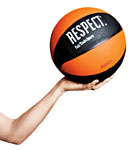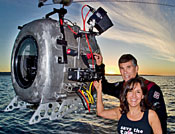sierraclub.org - sierra magazine - march/april 2009 - enjoy


Enjoy | The Green Life
By Avital Binshtock
Slam-Dunk Snacks and Sips
 March Madness means college basketball, which means game-watching parties, which means snacking and drinking, which means chips, soda, and maybe a beer or two.
March Madness means college basketball, which means game-watching parties, which means snacking and drinking, which means chips, soda, and maybe a beer or two.
We at Sierra have done the dribbling for those of you who want to make your refreshments as earth-friendly as they are tasty. We tracked down the greenest brands, blind-tasted them, and ranked them according to our collective preferences (see below).
Whichever flavor you choose, it's best to buy chips and soda in larger containers to avoid the waste of single-serving packaging. And if you get inspired to shoot some hoops, try Fair Trade Sports' vegan basketball; it's made of sustainably sourced rubber.
Chips
 #1 Kettle Brand Salt & Fresh Ground Pepper | Of the five brands we tested, Kettle was the runaway winner. The company recycles waste oil into biodiesel, uses solar and wind power, and restores wetlands. These chips are "very good," "crunchy, and a little greasy."
#1 Kettle Brand Salt & Fresh Ground Pepper | Of the five brands we tested, Kettle was the runaway winner. The company recycles waste oil into biodiesel, uses solar and wind power, and restores wetlands. These chips are "very good," "crunchy, and a little greasy."
#2 Kettle Brand Organic Chipotle Chili Barbeque | These chips earned high marks for flavor and texture. Tasters called them "bold and spicy" with "good saltiness," although they were too sweet for some taste buds.
#3 SunChips Original | Frito-Lay, which uses solar energy at its Modesto, California, plant, manufactures these "wholesome," "very light and crispy" chips. Naysayers called them "bland" and "weird."
Soda
 #1 Organics Lemon Italian Soda | This "delicious" variety of Safeway's organic brand has a "strong citrus flavor" that's "peppy," "perfectly tangy," and "refreshing." "Yum!"
#1 Organics Lemon Italian Soda | This "delicious" variety of Safeway's organic brand has a "strong citrus flavor" that's "peppy," "perfectly tangy," and "refreshing." "Yum!"
#2 Virgil's Root Beer | Packaged in recycled bottles, Virgil's is "good and frothy" with a "tasty," "light root beer" flavor and a "buttery" finish.
#3 Reed's Extra Ginger Brew | Some found the spicy-sweet flavor "odd," but most judged it "fresh," "light," and "natural tasting." Reed's supports Tree People, a nonprofit focused on planting trees, environmental education, and water management.
Beer
 #1 Anderson Valley Brewing Company Boont Amber Ale | This "smooth" beer, produced in a solar-powered facility, is "flavorful but not overwhelming" with a "gorgeous color," "pleasant nuttiness," and "nice head." It is, as one tester noted, a "serious beer."
#1 Anderson Valley Brewing Company Boont Amber Ale | This "smooth" beer, produced in a solar-powered facility, is "flavorful but not overwhelming" with a "gorgeous color," "pleasant nuttiness," and "nice head." It is, as one tester noted, a "serious beer."
#2 Sierra Nevada Pale Ale | Most agreed they "could down a couple of these quite happily," thanks to its "nice color"; "toasty," "hoppy" flavor; and "sweeter aftertaste." Sierra Nevada conserves water, uses fuel-cell power, and recycles.
#3 Organic Great Scot Pale Ale | Noting its "nice caramel color," the majority found this organic Scottish ale "strong but not too strong," though a few called it "a little too sweet."
Trendsetter: Christopher Swain, long-distance swimmer
"I've gotten rashes and had my lymph nodes swell up to golf-ball size from swimming through sewage."
--Christopher Swain
The first person to swim the length of the Columbia River (more than 1,200 miles) is a passionate guy. And not just about his sport, but about rivers and oceans too, and about teaching people why it's important to keep them clean. In April, Swain, who has also swum the Hudson and Charles Rivers (315 and 80 miles, respectively), will attempt to swim more than 1,000 miles from Marblehead, Massachusetts, to Washington, D.C.
Q: How do your swims raise awareness of clean-water issues?
A: If you're in the business of conservation, you've got a responsibility to get outside. You're not doing your job if you don't. It's not about e-mail blasts. It's about what you can go out there and experience and come back and testify to. If you look at the people who've really done anything--John Muir, David Brower, Rachel Carson--you can feel it in their writing. Your credibility is going to come from your experience.
Q: Do you worry that the water's toxicity will affect you?
A: Yeah, so I manage my risk. I hardly eat seafood to avoid accumulating mercury. I go to a clinic to test for PCBs, I wear goggles and earplugs, I gargle hydrogen peroxide, I don't swim near pipes, and I'm judicious about not swimming within three days of rain to avoid runoff.
Q: How are you preparing for your swim from Massachusetts to D.C.?
A: I train six days a week for one to four hours a day. I do ocean swimming and biking. I lift a ton of weight to build muscle to protect my joints. I want to know that I've trained so hard that I'm not going to think there's anything I could have done to be better prepared. If you go in with an uncertain heart, you're gonna pay. I have kids, so I don't wanna pay.
Q: Describe your education efforts.
A: I do school visits with slide shows and videos. My dastardly plan is to get 250,000 kids bugging their parents to protect the water. I haven't written off adults, but time spent educating kids is so leveraged that it's worth more.
Q: How can adventure enthusiasts take on a sport for a cause?
A: Pick something you feel connected to and let your heart carry you. Athletics is about heart. It's the organ that dominates our experience.
ON THE WEB To follow Christopher Swain's Atlantic swim, go to toxtour.org.
Underwater Odyssey
 Now playing on the big, big screen: Under the Sea 3D, an IMAX flick that shows little-known sea creatures much larger than life and in all their three-dimensional glory. Filmmakers Howard and Michele Hall (pictured) shot gorgeous--and sometimes devastating--footage of marine life in the teeming waters around Papua New Guinea, Indonesia, and Australia. IMAX, a Canadian company, recruited fellow Canuck Jim Carrey to narrate.
Now playing on the big, big screen: Under the Sea 3D, an IMAX flick that shows little-known sea creatures much larger than life and in all their three-dimensional glory. Filmmakers Howard and Michele Hall (pictured) shot gorgeous--and sometimes devastating--footage of marine life in the teeming waters around Papua New Guinea, Indonesia, and Australia. IMAX, a Canadian company, recruited fellow Canuck Jim Carrey to narrate.
Sequences include encounters with the highly venomous stonefish, playful sea lions, a yet-to-be-named shark species, and the captivating leafy sea dragon. A key message is how terribly global warming will damage the oceans' living things.
Lights Out
 Hundreds of thousands of people across the globe have already signed up to flip the switch for Earth Hour 2009. Last year's event was the largest voluntary power-down ever: More than 50 million people in 35 countries turned off their lights for 60 minutes.
Hundreds of thousands of people across the globe have already signed up to flip the switch for Earth Hour 2009. Last year's event was the largest voluntary power-down ever: More than 50 million people in 35 countries turned off their lights for 60 minutes.
The campaign started in Sydney in 2007. That year the city's carbon consumption dropped by more than 10 percent during Earth Hour. If Sydney maintained that level of energy reduction year-round, it would be the equivalent of taking almost 50,000 cars off the road. To pledge your participation, sign up at earthhour.org--and on March 28, go dark between 8:30 and 9:30 p.m.
Pet Peeve
 The U.S. pet industry is now a $43 billion-per-year behemoth, author Michael Schaffer reports in his upcoming book, One Nation Under Dog: Adventures in the New World of Prozac-Popping Puppies, Dog-Park Politics, and Organic Pet Food. That's more than double what we spent on pets 15 years ago. Since ecofriendly pet products and services fetch only $1 billion of the transactions, Americans would have to harness the power of a whole lot of hamster wheels to make up for Rover's and Fluffy's environmental pawprints.
The U.S. pet industry is now a $43 billion-per-year behemoth, author Michael Schaffer reports in his upcoming book, One Nation Under Dog: Adventures in the New World of Prozac-Popping Puppies, Dog-Park Politics, and Organic Pet Food. That's more than double what we spent on pets 15 years ago. Since ecofriendly pet products and services fetch only $1 billion of the transactions, Americans would have to harness the power of a whole lot of hamster wheels to make up for Rover's and Fluffy's environmental pawprints.
Backcountry Kitchen
Day six. John Muir Wilderness. Hungry. Tired. But my back's not sore 'cause my kitchen's light.
 Primus's EtaPackLite is the newest iteration in a bulkier line. The stove and its gas cartridge fit into the pot, but small doesn't mean weak: The adjustable flame boils a liter in three minutes and runs at 13,500 Btus per hour. A stuff sack is included. 21 oz., $115.
Primus's EtaPackLite is the newest iteration in a bulkier line. The stove and its gas cartridge fit into the pot, but small doesn't mean weak: The adjustable flame boils a liter in three minutes and runs at 13,500 Btus per hour. A stuff sack is included. 21 oz., $115.
 Solo Pack, made by Fozzils, comes with a dish, plate, cup, and spoon that start out flatter than a crepe. They fold and snap into 3-D shapes to hold food or drink. Though configuring them may take some initial fumbling, it's worth the effort to have bisphenol-A-free plastic dishes that pack perfectly flat and, all told, weigh less than a plastic file folder. 4.1 oz., $15.
Solo Pack, made by Fozzils, comes with a dish, plate, cup, and spoon that start out flatter than a crepe. They fold and snap into 3-D shapes to hold food or drink. Though configuring them may take some initial fumbling, it's worth the effort to have bisphenol-A-free plastic dishes that pack perfectly flat and, all told, weigh less than a plastic file folder. 4.1 oz., $15.
 Yes, you can bring a Kitchen Sink. Sea to Summit's 5-, 10-, and 20-liter versions, made of nylon and stainless-steel cable, provide a convenient, freestanding way to wash dishes at a safe distance from rivers and streams. They come with carrying handles and their own storage case. 3 oz., $17; 4.4 oz., $20; 6.4 oz., $23.
Yes, you can bring a Kitchen Sink. Sea to Summit's 5-, 10-, and 20-liter versions, made of nylon and stainless-steel cable, provide a convenient, freestanding way to wash dishes at a safe distance from rivers and streams. They come with carrying handles and their own storage case. 3 oz., $17; 4.4 oz., $20; 6.4 oz., $23.
 The Sea to Summit's AlphaLite Cutlery set includes an aluminum knife, fork, and spoon made featherweight in part because they're pocked with rounded hexagonal holes that let them double as tightening tools. A tiny carabiner holds everything together. 1.3 oz., $15.
The Sea to Summit's AlphaLite Cutlery set includes an aluminum knife, fork, and spoon made featherweight in part because they're pocked with rounded hexagonal holes that let them double as tightening tools. A tiny carabiner holds everything together. 1.3 oz., $15.
Green Biz
It's hard to throw out old electronics. But it's hard to keep 'em too. Whether you're an eager early adopter, frustrated by obsolete software, or dealing with technical malfunctions, there inevitably comes a time to bid adieu to your cell phone, computer, digital camera, or MP3 player.
Eco-conscious gearheads would never toss them into the trash, dooming them to become a droplet in the toxic e-waste tidal wave. This year, in the United States alone, more than 300 million electronic devices will be banished to the landfill. It needn't be that way.
Enter Gazelle, Flipswap, TechForward, and a spate of other relatively new companies trying to earn some green by buying, then reselling or recycling, used electronics from the general public.
Are they for real? Venture capitalists seem to think so: They're pouring tens of millions of dollars into these businesses in hopes of simultaneously cashing in and doing good. With luck and enough participation--and if consumers don't infer that it's now acceptable to discard slightly older gadgets for newer, cooler ones--this trend might help ameliorate the environmental and health problems associated with e-waste.
Grapevine
Last December thousands
of delegates convened at the United Nations Climate Change Conference in Poznan', Poland. The gathering served as a summary of 2008's environmental progress and a prelude to this year's early-December meeting in Copenhagen, where, if all goes as planned, a climate-change deal will solidify implementation of the Kyoto Protocol before its impending expiration in 2012.
The Buzz
We [will] end up with millions of small farmers all over the world being driven off their land and into unsustainable, unmanageable, degraded, and dysfunctional conurbations of unmentionable awfulness."
--Prince Charles warning against reliance on mass-produced, genetically modified crops in an interview with the Daily Telegraph
Good Eats
A few extra ounces in your backpack can turn a bare campsite into a gourmet kitchen, contends Robin Donovan. She wrote Campfire Cuisine (Quirk Books, 2006), a cookbook filled with delectable dishes she made while camping, like lemony couscous salad, coconut shrimp, and jambalaya. Here's her recipe for a hot-biscuit treat:
Skillet Scones
2 cups flour
2 teaspoons baking powder
1 teaspoon baking soda
1 teaspoon salt
3 tablespoons
plus 1 teaspoon sugar
3/4 cup buttermilk
1 stick butter, melted and cooled
1 egg, lightly beaten
(or 1/4 cup egg substitute)
At home: Mix the flour, baking powder, baking soda, salt, and sugar. Store the mixture in a ziplock bag.
At campsite: Combine all ingredients, including the mixture you made at home, in a bowl, using your hands to form a soft, sticky dough. Break off a chunk, roll it into a ball, and flatten it to a half-inch-thick, two-and-a-half-inch-wide patty. Repeat with remaining dough. Grease a skillet with butter and place over medium-low heat. When the skillet is hot, add the patties, pressing them down a bit. Cook covered, turning the scones over after four minutes, or when the bottoms have browned. Replace the lid and cook four minutes more, or until the bottoms are golden brown and the biscuits are cooked through. Serve hot. Makes about 16 small scones.
Photos by Lori Eanes (4); Basil Childers; Michele Hall, used with permission by Warner Bros. Entertainment Inc.; iStock/maiteali; Primus Camping; Lori Eanes (3);
illustration by Josef Gast